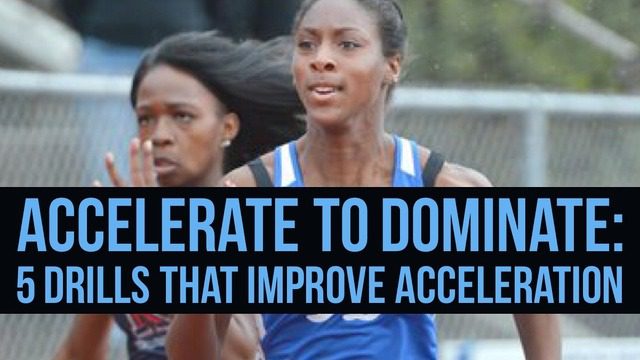Accelerate to Dominate: 5 Drills That Improve Acceleration
Speed & Agility | Sports PerformanceABOUT THE AUTHOR

JOEL SMITH
Joel Smith, MS, CSCS is a NCAA Division I Strength Coach working in the PAC12 conference. He has been a track and field jumper and javelin thrower, track coach, strength coach, personal trainer, researcher, writer and lecturer in his 8 years in the professional field. You can connect with Joel on his website.
Like most things in Strength and Conditioning, acceleration is extremely trainable. It’s entirely possible for an athlete to hack tenths of a second off of their 40 like butter with a good training program, and this shows up big-time on the field.

Acceleration is more closely linked to strength and plyometric power than is top speed, which must be trained more specifically. There are plenty of strength and power methods which carry over into acceleration ability, but it is also very important that the skill of acceleration is honed alongside power gains.
To improve one’s acceleration, specific practice is also a must, but there are more ways to approach it, and it is important to know that acceleration is a skill that is easily gained (and lost). To maximize the skill component of accelerating, one can and should do drills that bleed speed, power and coordination together.
// 5 concepts to build blistering acceleration
Your Title Goes Here
Your content goes here. Edit or remove this text inline or in the module Content settings. You can also style every aspect of this content in the module Design settings and even apply custom CSS to this text in the module Advanced settings.
1. Start Complex
The best way to build a robust acceleration pattern is accelerating competitively from a variety of starting positions. A robust pattern is one that can be utilized in a variety of sporting situations, and it also has more room for gains, since it is more stable and well-rounded.
The start complex is performed circuit style, and includes 5-6 total types of starts, performed as a race, over 10-20 meters distance. These starts include:
- Pushup Starts
- Scramble Starts
- Mountain Climber Starts
- Rollover Starts
- Falling Starts
- Donkey Kick Starts
You can also be creative and do various lateral starts (we’ll get to this in drill 3), seated starts, tall kneeling starts, or anything you can creatively design. Nothing is off the table, and the race factor allows an athlete to self-organize the movement into an effective pattern.
Many of these types of starts are shown in the video below:
An acceleration complex workout could be written as follows:
2x15m of the following:
- Pushup Start
- Mountain Climber Start
- Donkey Kick Start
- Falling Start
2. Standing Triple Jump
The standing triple jump is one of the best ways for athletes to improve the power of their stride over short distances. Athletes who have a great standing triple jump are also likely to run a fast 40 yard dash, and have a great vertical leap.
Since acceleration places a high demand on coordination, it is important to have assisting exercises that also place a significant demand on coordination. The standing triple jump requires both coordination and power.
To perform this high-transfer assisting exercise, start in a standing position, and perform a forward jump off of two legs, followed by a hard jump forward off of your left leg, and then your right leg (or vice versa). Preferably, you’ll land in a sand pit, but if this in unavailable, try for grass.
The key to performing the standing long jump, or any other “multiple jump” is to be sure to place a cone or marker out when jumping to help the subconscious mind self-organize a pattern to beat one’s former distances. As Christopher Glaeser of Freelap USA says, “what you measure, you improve”, and science is firmly behind this statement.
One thing I will say about this drill, is that it is addictive. Some athletes would actually rather keep bounding all day than work on other acceleration skills, which is actually a dangerous scenario, because, the number one rule of building killer acceleration is to actually practice acceleration, but, none-the-less, the standing triple jump is an incredible supporting exercise.
3. Medicine Ball Starts
The next key tool for linear acceleration is medicine ball starts, and medicine ball jump starts. To perform this simple exercise, stand with a medicine ball, and perform a standing long jump while simultaneously throwing the medicine ball forward down the track (or wherever you are running), and bleed this jump into a powerful acceleration. This can be done alone, or as a two to three person race.
Athletes are not just limited to one jump here, but can perform multiple leaps. Click here to view a video of a multi-hop medicine ball start.
In my days of collegiate track and field coaching, we would progress from one hop to three over the course of fall training.
4. Lateral Kneeling Starts
The lateral kneeling start is a great way to teach athletes to use more of the “frictional” components of movement (aka. muscle fibers as opposed to tendons, etc.) to powerfully move laterally from a dead start. Many athletes with weaker legs will use strategies that rely on torso position and elastic energy to move, but this only creates a movement pattern that keeps one behind in team sport plays.
Even getting stronger in squats, deadlifts, and the like may not have the most profound effect on lateral speed if an athlete’s movement patterns are not honed in on getting the most of what they have to offer in the lateral plane!
The kneeling start is performed by assuming a kneeling position, and then rapidly accelerating laterally. It’s likely easier to describe by showing you a video below.
5. Hurdle/Sled Pushes
According to many of the great track coaches, and what we see in the biomechanical world, an incredibly important cue during acceleration is to “push”. This is because when accelerating, the foot will strike slightly behind the hips, and as an athlete gains speed, that footstrike starts to fall right under the hips, and then slightly in front when an athlete is upright and running full-out.
Once an athlete is at top-speed, the “push” cue is extremely counterproductive, but it can be very useful in acceleration.
To help athlete understand both “pushing” the ground back, and gain awareness of posture in the process, the hurdle push drill is a great way to approach learning acceleration in early training phases. This drill is incredibly simple, and all you need is a hurdle or a sled. Hold the hurdle about 24” off the ground, and drive as hard and fast as possible. Racing is good here.
This is a drill that naturally teaches an athlete the mechanics of pushing without them needing to think of anything, however, athletes with poor function/mobility will be very prone to poor posture (you can see a few athletes with rounded backs in the video above), so this is something that should really be coached up throughout this drill.
Conclusion
So there you have 5 key drills to help improve acceleration ability in both team sport and track athletes. Remember, most team sport plays are decided by acceleration, not top end speed, so improvement here is a must! Acceleration is a skill, so practice it year-round, and these 5 drills will provide plenty of ammunition to do so.
Are you a better coach after reading this?
More coaches and athletes than ever are reading the TrainHeroic blog, and it’s our mission to support them with usefull training & coaching content. If you found this article useful, please take a moment to share it on social media, engage with the author, and link to this article on your own blog or any forums you post on.
Be Your Best,
TrainHeroic Content Team
HEROIC SOCIAL
HEROIC SOCIAL
TRAINING LAB
Access the latest articles, reviews, and case studies from the top strength and conditioning minds in the TH Training Lab

